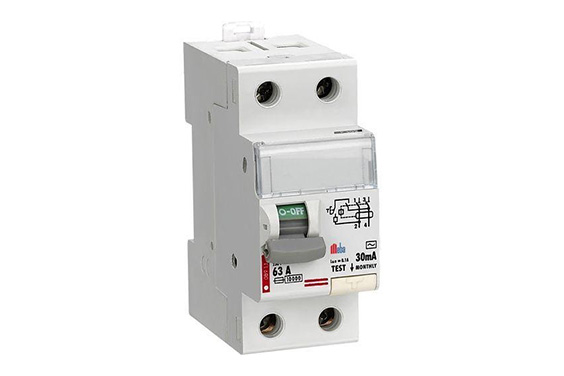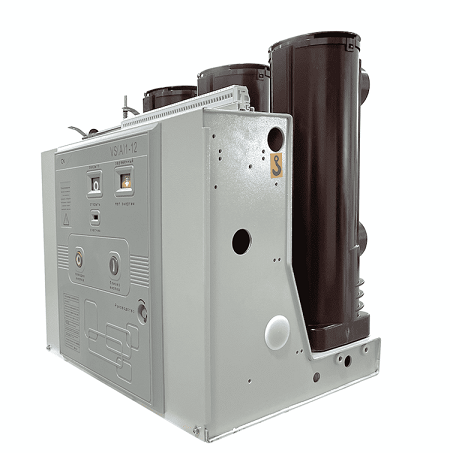Home » What Is A Circuit Breaker?
A circuit breaker is a good investment in today’s world and one of your home’s most vital safety features. When a building’s electrical wiring has too much electricity running through it, these devices shut the electricity until the issue is solved. Household power would be untenable without an HV circuit breaker due to the risk of fires and other havoc caused by basic wiring issues and equipment breakdown.
An industrial circuit breaker is a technical device used to protect an electrical circuit from being damaged by a large current flow or a short circuit. It’s an automatically operated switch that’s primarily created to keep electrical systems secure by blocking aberrant or fault currents.
A circuit breaker’s purpose is equatable to a fuse switch and an under-thermal relay, and it could be used to deliver power, begin an asynchronous motor occasionally, safeguard the power cable and motor, and effectively cut off the circuit in event of serious overload, short-circuit, or under-voltage faults. The operation is similar to that of a fuse switch and an under-thermal relay, for example. After breaking the fault current, there is usually no need to alter parts. They are currently in widespread use.
Here are some kinds of circuit breakers:
They are further divided into two categories:

A fixed type circuit breaker is legally required in all electrical systems. In most cases, you’ll find them together in a breaker box. The purpose of a circuit breaker varies depending on the kind, but they always serve the same purpose: to cut off power.
A breaker is a device that identifies an abnormality in your power system, such as unusually high temperatures, a current imbalance, or a short circuit. It will trip if either of these things occurs. This closes the circuit and interrupts the supply of power.

The 3 main components of a high-voltage circuit breaker are:
Interrupting Chamber
The current conduction and disruption in the power circuit take place in the interrupting compartment. It’s normally a sealed container with the make-break connections and an interrupting media for arc quenching and insulation. The operating principle of high voltage vacuum circuit breaker is where the necessary energy is generated to close or open the contacts and quench the arc.
Frame
The circuit breaker’s interior parts are protected by the frame, which also accommodates the components. The arc is contained by the frame, which provides insulation.
Trip Unit
In the case of an overload, short circuit, or other unusual current flow, the trip unit of indoor vacuum circuit breaker detects it. The functioning mechanism opens the contacts as a result of this.
Vacuum interrupter
The vacuum interrupter is the core component of the medium voltage vacuum circuit breaker. Its main function is to quickly extinguish the arc and suppress the current after the medium and high voltage circuit is cut off through the excellent insulation of the vacuum in the tube, so as to avoid accidents and accidents.
The three main components of a low-voltage power breaker are:
Frame
The indoor circuit breaker components are mounted on the frame, which offers an insulated enclosure. The frame defines the physical dimensions of the circuit breaker as well as the maximum voltage and current that can be applied. The operational mechanism allows the breaker contacts to be opened and closed.
The working mechanism handle, in addition to signaling whether the breaker is open or closed, also signals whenever the breaker has automatically tripped by shifting to a position halfway between on and off.
Arc Extinguisher
When the circuit breaker blocks current, the arc extinguisher restricts, separates, and annihilates the arc produced between contacts. Arc extinguishers are made up of a series of connections that gradually open, separating the arc and rendering it simpler to contain and extinguish. Circuit breakers that control a high amount of electricity, such as those seen in power distribution panels, typically use arc extinguishers.
Terminal Connectors
Terminal connections connect the circuit breaker’s contacts to the circuit and give a way of connecting the circuit breaker to the circuit. The trip component is the portion of the circuit breaker that detects an overload condition and trips or breaks the circuit.
Molded circuit breakers are made up of four major parts.
Frame
The frame is an insulated enclosure in which all of the circuit breaker parts are mounted. This is typically constructed from a glass-polyester or thermoset composite resin that blends toughness and excellent dielectric strength in a small package. Each variable type and size of the molded enclosure is given a frame identifier.
Operating Mechanism
The operating mechanism is responsible for the opening and shutting of the contacts. The pace at which the contacts open or close is unrelated to the speed at which the handle is moved.
Arc Extinguishers
When a circuit breaker blocks a current flow, an arc is formed. The job of the Arc Extinguisher is to contain and separate the arc, effectively extinguishing it. Arc extinguishers are typically made up of 2 insulator plates holding a stack of steel plates together. The current flow via the ionized zone of the contacts creates a magnetic field surrounding the arc and the arc extinguisher when the connections separate due to an interruption.
The mechanical energy contained in the trip mechanism makes up the majority of the opening act. This is due to the fact that the currents in both contacts are flowing in the same direction and are attracted to one another. Breakers with newer designs use a reversal loop, with current flowing in virtually opposite directions. This results in a repelling action and a higher blow-apart force.
Trip Units
The Trip Unit is the circuit breaker’s brain and its job is to trip the working principle in the case of a short circuit or a sustained current overload. Electromechanical trip devices are used in traditional molded case circuit breakers. A temperature-sensitive technology and a current-sensitive electromagnetic technology, both act mechanically on the trip mechanism to provide safety.
Electronic trip units can provide far more comprehensive safety and monitoring than traditional trip units. To offer circuit protection for various applications, most molded case circuit breakers use one or more separate trip components.

Circuit breakers are composed of pairs of fixed and moving metallic contacts, as well as an operational coil, on the inside. Under normal circumstances, these contacts are in touch with one another, enabling electric current to pass. The mechanical pressure exerted by another device – such as a spring or compressed air – keeps these moving connections together.
The potential stored energy in the aforementioned pressure mechanism allows for this pressure on the moving connections. When the electrical circuit is overloaded, the operational coil is packed with energy, and a plunger attached to the moving contact mechanism enables the energy stored in this mechanism to be discharged, allowing the moving contacts to divide as well.
The circuit inside the draw out breaker opens as the moving contacts split, preventing the flow of current and safeguarding the system from further harm.
It is critical, however, that you comprehend the concept of “arc.” A plasma discharge known as arc develops when an electrical current travels through an open hole from an energized part to a neutral part. Lightning, for example, is a broad arc that crosses atmospheric space from a cloud to the earth or another cloud.
Arcing can occur in electrical wiring, as well as within circuit breakers during operation, causing damage and fires if the arc is not regulated. As a result, the mechanism of circuit breakers is to control and prevent the creation of these electric arcs as much as feasible.
The advantages of using a circuit breaker are:
The disadvantages of using a circuit breaker are:
The applications of a circuit breaker include:
A circuit breaker’s rating includes the following information:
Short-circuit breaking current
This is the maximum short circuit current that a withdrawable circuit breaker can tolerate before being cleared by opening its connections. When a short circuit passes through a circuit breaker, the current-carrying elements of the breaker are subjected to heat and mechanical strains. If the area of contact and cross-section of the circuit breaker’s conducting parts are insufficiently big, there is a risk of irreversible damage to the circuit breaker’s insulation and conducting components.
The breaking ability of an electrical circuit breaker is dependent on the working time because the thermal stress in the circuit breaker is proportional to the duration of the short circuit. At 160°C, aluminum softens and loses its mechanical strength, hence this temperature can be used as a limit for breaker contact temperature rise during a short circuit.
As a result, circuit breaker short circuit breaking capability is defined as the maximum current that can run through the breaker from the point a short circuit occurs to the point the short circuit is cleared without causing irreversible damage to the circuit breaker.
Rated Short Circuit Making Capacity
The maximum current of a circuit breaker’s short circuit producing capacity is not the same as the RMS value of the breaker’s breaking capacity. The fault current in a system can potentially surge to twice its symmetrical fault level at the time of fault incidence.
The short circuit section of the system is connected to the source at the time of turning on a circuit breaker in a faulty condition. The circuit breaker closes the initial cycle of current in a circuit, which has the greatest amplitude. The magnitude of the symmetrical fault current waveform is around double that.
The rated short circuit generating a current of a circuit breaker is always greater than the rated short circuit breaking current of a circuit breaker since it is indicated in the highest peak value. Short circuit generating current is normally 2.5 times that of short circuit breaking current.
Rated Operated System
The circuit breaker’s functioning mechanism has a mechanical duty requirement. A circuit breaker’s rated operational duty is listed in the following order:
O-t-CO-t’-CO
Where O denotes the CB’s opening operation.
CO denotes the time it takes for a closing operation to be succeeded by an opening operation with no intended time delay.
t’ is the time between two operations that are required to recover the initial conditions and/or prevent excessive heating of the circuit breaker’s conducting portions. For the circuit breaker, t = 0.3 seconds
If not otherwise indicated, this item is meant for the first auto-re-closing function.
Assume a circuit breaker’s rated duty circle is:
0-0.3 seconds-CO 3 minutes- CO
This signifies that a circuit breaker’s opening operation is accompanied by a closing operation after an interval of time of 0.3 seconds, and the circuit breaker then opens again with no intended time delay. After this opening procedure, the circuit breaker is closed for 3 minutes before tripping without any intentional time delay.
Rated Short Time Current
This is the maximum current that a breaker can safely carry for a given period of time without causing harm. When a failure occurs in the system, the circuit breakers do not discharge the short circuit current. Between the time the fault occurs and the point circuit breaker clears the fault, there are always some planned and unintentional time delays.
This delay is caused by the time it takes for protection relays and circuit breakers to operate, as well as any purposeful time delays implemented in relays for effective power system protection coordination. Even if a circuit breaker does not trip, the fault will be rectified by the circuit breaker above it.
The fault clearance time is longer in this instance. As a result, after a fault, a circuit breaker must withstand the short circuit for a specified period of time. A circuit breaker should be capable of transporting a maximum defective current for at least this short length of time, as the sum of all time delays should not exceed 3 seconds.
Rated Voltage of Circuit Braker
The insulation system of a circuit breaker determines its voltage levels. The circuit breaker is designed to tolerate 10% above the typical system voltage for systems below 400 KV. Circuit breaker insulation should be able to withstand 5% well above typical system voltage for systems above or equal to 400 kV.
That is, the circuit breaker’s rated voltage matches the greatest system voltage. This is because the voltage level of the power system is permitted to climb to the maximum voltage rating of the system during no-load or small load conditions.

Preventative maintenance
Circuit breakers are sometimes overlooked when it comes to maintenance because they can sit idle for extended periods of time, both open or closed. As transmission networks expanded and transmitted more energy over longer distances, the requirement to forecast the correct working of circuit breakers grew.
The advancement of technology has resulted in low-maintenance breakers, but it hasn’t given network managers more confidence in the operation’s dependability.
Maintenance that is planned in advance
The term “predictive maintenance” was coined by maintenance personnel. The goal is to accurately estimate the breaker’s state without having to open it for examination.
The necessary open examination would then be restricted to remedial or preventive intervention, lowering the cost of maintenance while boosting efficiency to the same level.
The forecast can be made in three different methods, all of which are complementary to one another:
We can all agree that circuit breakers are an integral aspect of any electrical system and that their appropriate use is critical. An engineer must understand the fundamentals and functioning concepts of circuit breakers, as well as the proper choice of circuit breakers based on the application.
Finally, even if you’re a do-it-yourselfer, you should leave electrical work to the professionals. Your circuit breaker box isn’t as straightforward as the rest of your household appliances. If you try to meddle with the multiple cables, breakers, and voltage offerings in your panel, you could end up causing serious damage, especially if you’re trying to find a solution for often tripping breakers. Simply said, you should get your circuit breaker box examined by a professional if you suspect a problem and get circuit breakers from reliable circuit breaker brands.
Equip your business with long-lasting switchgear components that respond to your needs and smoothen electrical operations at affordable costs.
Supported File : JPG, AI, PNG, PDF, CAD, JPEG